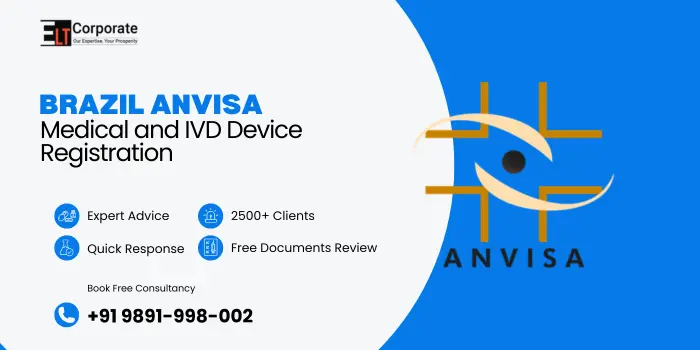Brazil ANVISA Medical and IVD Device Registration explains how manufacturers and importers get legal approval to sell medical devices and in-vitro diagnostics (IVDs) in Brazil. This guide uses clear, plain words and focuses on current ANVISA rules (including the recent IVD regulation and UDI rollout) so you can understand the practical steps and documents you’ll need.
Who is ANVISA?
ANVISA (Agência Nacional de Vigilância Sanitária) is Brazil’s national health regulatory agency. It controls the safe production, import, sale and post-market surveillance of medical devices and IVDs in Brazil. All medical devices/IVDs placed on the Brazilian market must follow its rules.
What is a Medical Device vs an IVD?
- Medical device: any instrument, apparatus, material or software intended for medical use (therapy, diagnosis, monitoring, etc.).
- IVD (in-vitro diagnostic): a device used to examine samples (blood, tissue, swabs) to get information about health/disease. IVDs have their own updated rules from ANVISA (RDC 830/2023).
Device Risk Classification
ANVISA uses four risk classes for both medical devices and IVDs: Class I (lowest risk) → Class II → Class III → Class IV (highest risk). Classification determines whether you need a simple notification (lower classes) or full registration (higher classes) and what evidence ANVISA will require. The new device rules (RDC 751/2022 for medical devices and RDC 830/2023 for IVDs) define classification rules and examples.
Understand the Difference Between Notification And Registration
Notification: For many Class I and some Class II devices. It is a simpler electronic listing in ANVISA’s system and typically does not expire (but can be revoked).
Registration: Required for Class III and Class IV devices (and some special Class II). Registration is a formal pre-market approval where ANVISA reviews technical and safety evidence; approvals usually have a validity period (e.g., 10 years).
What Is the Step-by-Step Process for Brazil ANVISA Medical and IVD Device Registration?
- Decide device type and classification (use ANVISA rules): determine if it’s IVD and which risk class.
- Appoint a Brazilian Representative / Responsible Person (local legal/technical rep required for foreign manufacturers).
- Prepare technical file (device description, design, clinical data if needed, labelling, instructions for use (IFU), risk analysis, test reports, sterilisation info if applicable).
- Quality system / BGMP evidence for Class III/IV (ANVISA may require a BGMP certificate or audit). MDSAP acceptance can help.
- Submit the application in the appropriate ANVISA system (notification portal or registration dossier). Pay ANVISA fees.
- Respond to ANVISA queries (they may ask for clarifications or additional tests).
- If approved, publish registration (for Registro) or confirm notification; then meet post-market obligations (vigilance, periodic reports, labelling/UDI).
Required Documents for Brazil ANVISA Medical and IVD Device Registration
- Cover letter/application form (ANVISA format).
- Administrative documents: company registration, power of attorney, contract/appointment of Brazilian Rep.
- Device description and intended use.
- Technical file: design, BOM, drawings, software description (if applicable).
- Risk analysis (e.g., ISO 14971 summary).
- Performance/bench test reports and manufacturing process description.
- Sterilisation validation and shelf-life studies (if relevant).
- Biocompatibility data (for body-contacting devices).
- Clinical evidence (if required by risk class or device type).
- Labelling and IFU in Portuguese (mandatory).
- BGMP (Good Manufacturing Practices) certificate or evidence of a quality management system for higher-risk devices; MDSAP certificate if available.
What Are BGMP, GMP, and MDSAP, and What Does ANVISA Look for During Medical and IVD Device Registration?
- ANVISA requires evidence of compliant manufacturing systems for Class III and IV devices. Historically, this was called BGMP (Boas Práticas de Fabricação). ANVISA may conduct on-site audits.
- ANVISA increasingly accepts MDSAP (Medical Device Single Audit Program) or other recognised certificates to reduce duplicative inspections; MDSAP evidence can extend BGMP certificate validity in some cases.
What is the Timeline for Brazil ANVISA Medical and IVD Device Registration?
- Notification (Class I/II): can be relatively fast – weeks to a few months (primarily depends on completeness).
- Registration (Class III/IV): can take several months to over a year, depending on ANVISA backlog, complexity, and whether on-site audits are needed. Reliance pathways can shorten review time for eligible products.
What Are Common Pitfalls and Practical Tips in ANVISA Registration?
- Wrong classification: misclassifying a device is a frequent error – use ANVISA classification rules and guidance documents.
- Incomplete technical file: missing test reports, insufficient clinical evidence, or no Portuguese IFU causes delays.
- No local representative: ANVISA requires a Brazilian responsible person for foreign manufacturers – ensure this is appointed with proper power of attorney.
- Underestimating BGMP audits: prepare for possible inspections for Class III/IV. Consider obtaining MDSAP to smooth the process.
How Long does ANVISA Registration take for a Class IV Device?
It commonly takes several months to over a year, depending on dossier completeness, inspections, and ANVISA workload.
Can I Use an FDA or CE Approval to Speed up ANVISA Registration?
Yes – ANVISA has reliance/optimised routes (e.g., IN 290/2024) that can shorten review if your product is approved by a trusted regulator and you meet eligibility.


Comments are closed